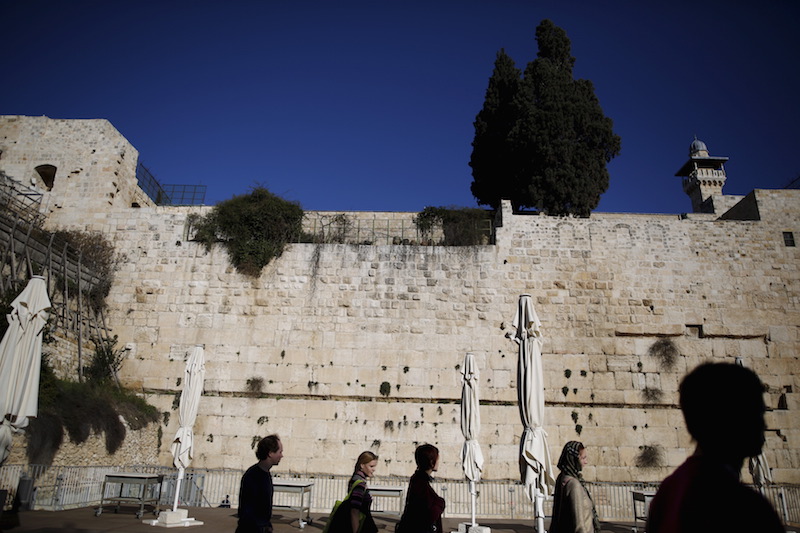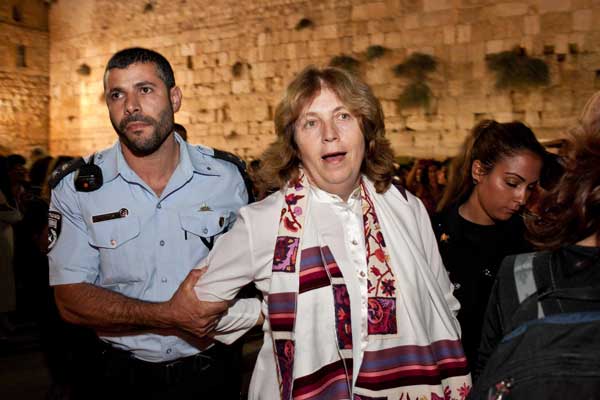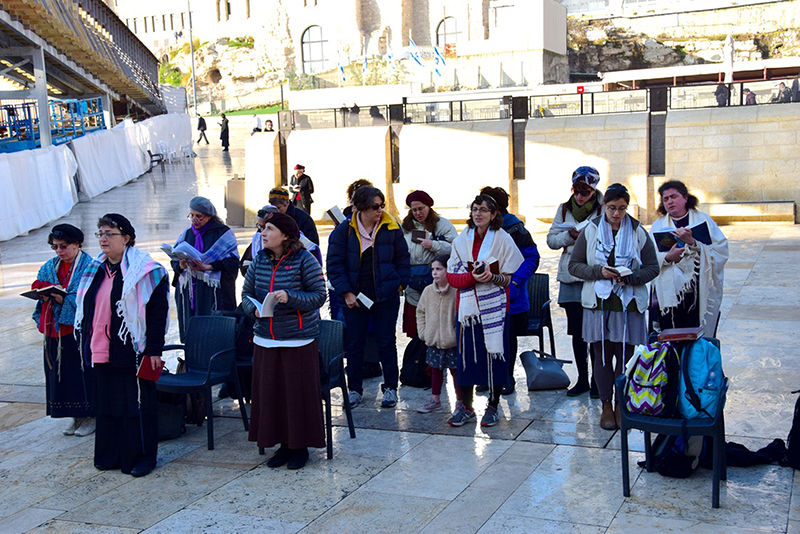
Tourists walk by part of the Western Wall after the Israeli government’s approval to create a mixed-sex prayer plaza to accommodate Jews who contest Orthodox curbs on worship by women at the site, in Jerusalem’s Old City, on Jan. 31, 2016. Photo courtesy REUTERS/Amir Cohen
*Editors: This photo may only be republished with RNS-WALL-DEAL, originally transmitted on Feb. 9, 2016.
(RNS) In about a year, women and men will be able to pray together at a space off to the side of the Western Wall, Judaism’s holiest site.
Ultra-Orthodox rabbis have prohibited men and women from praying together at the wall — known as the Kotel to many Jews — the remains of a retaining wall at Jerusalem’s Temple Mount. But many Conservative, Reform and Reconstructionist Jews have resented the separation.
Since 1988, a group called Women of the Wall has insisted that women be allowed to pray at the wall wearing the traditional tallit, or prayer shawl — a tradition ultra-Orthodox Jews reserve for men only.
Rabbi Steven Wernick, who heads the synagogue arm of Conservative Judaism, was a party to the talks that led to the acceptance of a mixed-gender section where men and women can pray in whatever tradition they want. RNS asked for his insider’s view of the negotiations and the final agreement. This interview has been edited for length and clarity.
Q: When did things really get rolling on creating this space?
A: Several years ago Anat Hoffman, of Women of the Wall, was arrested at the women’s section of the wall for carrying a Torah. She was, from the reports we heard, treated badly by the authorities. She was later arrested for reciting the Shema (a key Jewish prayer). That event really awakened the Diaspora Jewish community (Jews outside Israel). We had been arguing for years about pluralism, but at that moment, pressure started to build to do something about it.

The arrest of Anat Hoffman (pictured here), who co-founded Women of the Wall to enable Jewish women to pray together at the Western Wall, elicited outrage, especially from American Jews, the vast majority of whom do not practice Orthodox Judaism. RNS photo courtesy of Women of the Wall
Q: What was the role of Natan Sharansky, the famed Soviet dissident who is now a prominent Israeli politician?
A: Prime Minister Benjamin Netanyahu sent him several years ago to the U.S. to meet with American Jews who wanted more pluralistic prayer at the wall. Natan Sharansky came with a vision of “one wall for one people,” which included far more space for men and women to pray together than what the deal would eventually allow. At the end of the day it became clear that that wasn’t going to happen. But we have a fair and creative solution now. This is a big step forward in terms of Israel’s relationship to the Diaspora and Israel’s relationship to the fullness of Jewish experience in the modern world — there are alternative ways of being Jewish than what the Haredi (ultra-Orthodox) establishment presents.
Q: Negotiations stalled toward the end. What brought you over the finish line?
A: Avichai Mandelblit, Israel’s Cabinet secretary, had the toughest job. He had to negotiate with us, and then he had to negotiate with the rabbi of the Kotel, and then he had to negotiate with the Jordanians and the Waqf (who preside over the Al-Aqsa Mosque atop the Temple Mount), and with the archaeologists working at the wall. And he was doing a great job. We had gotten really close to a deal. But not close enough. Then Avichai was appointed as Israel’s attorney general. He was going to begin his new post. Our best opportunity was to conclude something before he left. Otherwise you’re starting over again.

Members of the Original Women of the Wall say morning prayers at the Western Wall in Jerusalem on Feb. 3, 2016. Photo courtesy of Shmuel Browns
Q: This new prayer space for men and women is relatively small — 900 square meters — and pushed toward the southern end. Disappointing?
A: I find the northern plaza to be too sterile. When you’re in the southern plaza, you have an opportunity to stand on the original Herodian road, that’s 2,000 years old, where pilgrims around the world would come and buy their sacrifices. They would actually enter the Temple Mount from the Southern Wall, not from the Western Wall.
Q: But you also want respect and equal treatment for non-Orthodox rabbis and traditions in Israel, right?
A: The job of a religious person is to remain optimistic and hopeful. I’m also a realist. We’re going to celebrate this achievement, and then we’re going to go back to work.
Q: What do Jews in the Diaspora get with this deal that they didn’t have before?
A: They have the opportunity to pray at Judaism’s most holy site according to their own traditions, without harassment. What Diaspora Jews also get is the knowledge that for the first time, the various streams of Judaism — Conservative, Reform, Reconstructionist — are partners with the government to care for one of Israel’s national, historic religious treasures. That’s huge. More than anything else, that’s the big victory.
(Lauren Markoe is a national reporter for Religion News Service)




